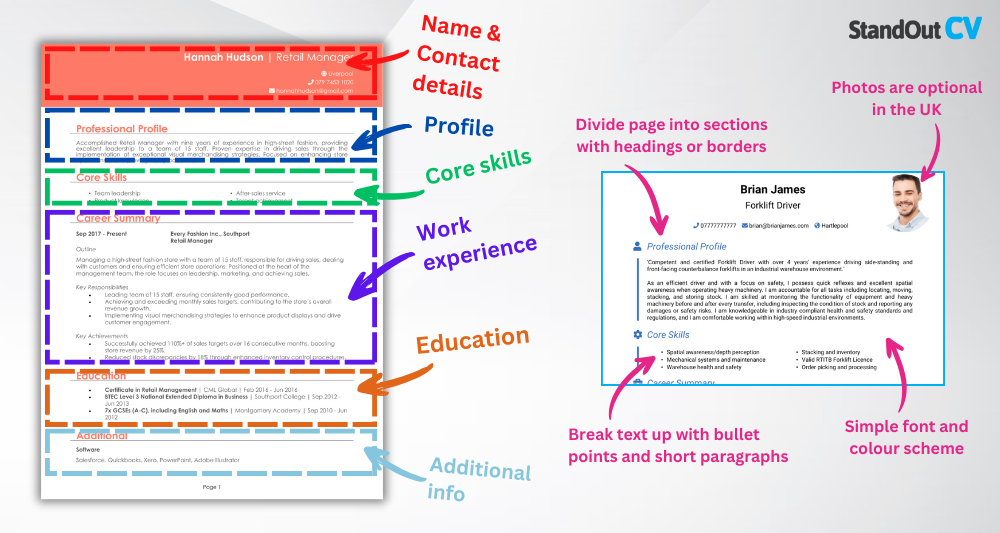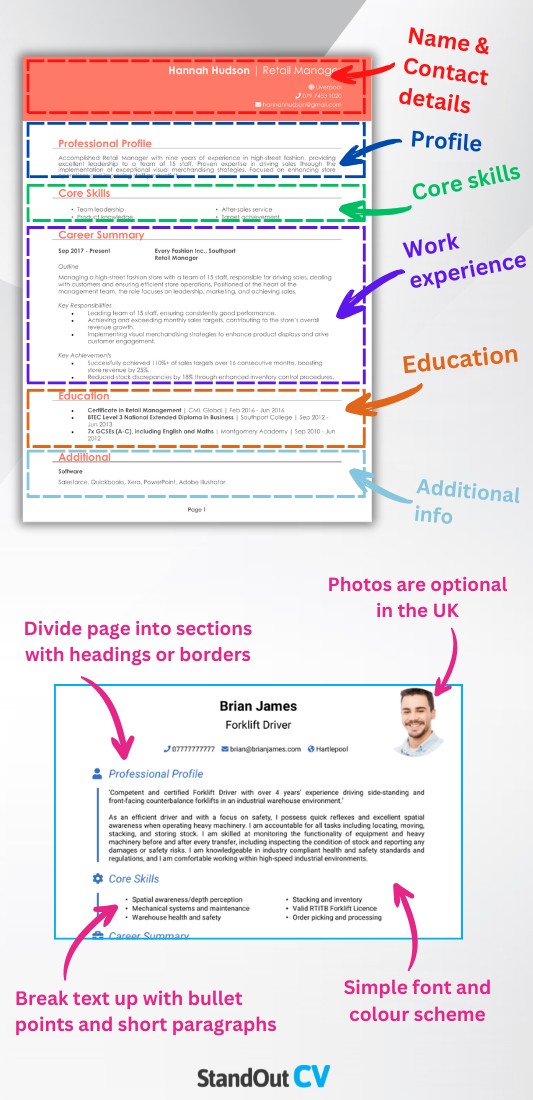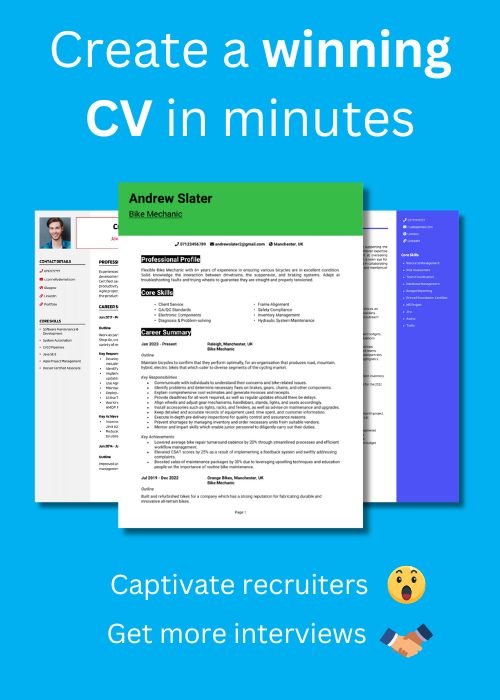Every recruiter is sifting through dozens of applications, and your CV has seconds to prove you’re the one who can keep releases running on schedule, on budget, and without nasty surprises.
Instead of opening with a wall of jargon, give them a document that’s as efficient and dependable as your best deployment.
In this guide and with the help of a Release Manager CV example, you’ll see exactly how to present your release management expertise in a way that’s easy to trust and impossible to ignore – setting you up for interviews that lead to the roles you want.
Release Manager CV sample

How to write your Release Manager CV
Discover how to craft a winning Release Manager CV that lands interviews with this simple step-by-step guide.
Releases don’t happen by accident – they’re the result of careful planning and follow-through. The same mindset works for writing your CV: organise the essential details, present them clearly, and make sure nothing critical gets lost in the process.
In the sections below, you’ll learn how to write a CV, focus on the details employers care about most, and position yourself as the go-to person for dependable delivery.
How should you structure and format a Release Manager CV?


A release plan without structure leads to missed steps – and the same applies to your CV. By presenting your experience in a logical, accessible way, you make it easier for recruiters to see why you’re the right choice. Mistakes in your CV’s structure will only confuse and frustrate recruiters, who will move onto the next candidate.
Here’s the layout to follow:
- Name and contact details – Place your name and personal details prominently at the top of your CV for quick access. Adding a photo is up to you.
- Profile – Open with a compelling overview of your skills, experience, and career goals.
- Core skills – List your key abilities in this section, focusing on those that will be most relevant to the job.
- Work experience – Provide a detailed breakdown of your work history, starting with the most recent job first.
- Education – List your qualifications, including degrees and relevant certifications, in reverse chronological order.
- Additional info – Use this optional space for relevant hobbies or personal pursuits that enhance your application.
When formatting, think “clear and consistent.” Use bullet points to break down text, and label sections with distinct headings. Make sure you opt for a clean, professional font, and keep it under two pages in length while leaving enough white space for an easy read – clarity always beats cramming.
Writing a Release Manager CV profile


Your CV profile should summarise your background while clearly showing the value you’d bring to an organisation’s release process.
Highlight your track record in coordinating releases, managing risks, and ensuring quality standards are met – but frame it in terms of the benefit to the employer, like smoother deployments and faster time-to-market. They need to understand the value you’re offering.
Release Manager CV profile examples
Profile 1
Experienced Release Manager with over 15 years in financial services and enterprise IT, overseeing large-scale software deployments across global platforms. Skilled in coordinating cross-functional teams, managing release schedules, and ensuring compliance with change management frameworks. Proficient in tools such as Jenkins, JIRA, and ServiceNow, with a strong track record of delivering releases on time while minimising disruption to business operations.
Profile 2
Organised Release Manager with eight years of experience in agile software development environments, specialising in SaaS and cloud-based solutions. Adept at planning and coordinating release cycles, managing risk assessments, and ensuring smooth integration across development and operations. Experienced in CI/CD pipelines and tools such as GitLab and Azure DevOps. Recognised for strong stakeholder communication and ability to balance speed with stability.
Profile 3
Motivated Release Manager with four years of experience in a fast-paced start-up, supporting weekly and on-demand releases for web and mobile applications. Skilled in monitoring deployments, resolving release issues, and maintaining documentation. Comfortable using Jira, Confluence, and Bamboo to track and manage delivery pipelines. Passionate about improving release processes and enabling rapid, reliable software delivery.
Details to put in your Release Manager CV profile
Try to include the following in your profile:
- Where you worked – Indicate the industries or organisations where you’ve gained experience, such as tech companies, financial institutions, or software vendors.
- Your top qualifications – Mention degrees, certifications, or specialist training relevant to release and project management.
- Essential skills – Summarise key abilities that align with the demands of a Release Manager role.
- Specialist areas or focus – Note any particular release environments, tools, or frameworks you have deep expertise in.
- Value delivered – Explain how your work has reduced downtime, improved quality, or enabled faster, safer releases.
Writing an effective core skills section


Think of this section as the “quick reference guide” to your CV – the equivalent of a high-level release checklist for recruiters. When they scan it, they should immediately see hard, tangible capabilities that match the role’s demands.
Avoid filler or vague buzzwords; instead, ensure each point is relevant to the employer’s expectations, ideally mirroring the requirements in the job description. This isn’t just a CV skills dump – it’s a targeted display that signals you understand what’s needed for success in their environment. The more closely it reflects their priorities, the more likely you are to be shortlisted.
The top skills to highlight in your Release Manager CV
- Release Planning and Scheduling – Coordinating the timing and scope of software releases to align with business objectives and development cycles.
- Deployment Management – Overseeing the deployment of code, updates, and patches across environments, ensuring minimal disruption.
- Change Control and Governance – Managing change requests and approvals while ensuring compliance with organisational policies and risk protocols.
- Cross-Functional Coordination – Collaborating with development, QA, operations, and product teams to ensure readiness for release.
- Version Control and Configuration Management – Tracking software versions and configurations to maintain consistency and traceability.
- Issue and Risk Management – Identifying, assessing, and mitigating risks and issues that could impact release timelines or quality.
- Continuous Integration and Delivery Support – Working with CI/CD pipelines to streamline builds, tests, and deployments.
- Release Documentation and Communication – Producing clear release notes, schedules, and stakeholder updates for transparency and alignment.
- Environment Management – Coordinating the setup and maintenance of test, staging, and production environments.
- Post-Release Monitoring and Reporting – Evaluating release performance, gathering feedback, and leading retrospectives to drive improvement.
Showcasing your work experience


Your work experience section should demonstrate how you’ve applied your expertise to manage complex release schedules, coordinate with multiple teams, and ensure final products are ready for deployment. Show not just what you did, but how your efforts benefited the organisation.
List roles in reverse chronological order, starting with your current or most recent position. For each, begin with a short outline of the role and organisation, then break down responsibilities and achievements into bullet points.
Writing job descriptions for past roles

- Outline – Describe the organisation, your role, and the overall aim of your work, noting who you reported to and the types of releases you managed.
- Responsibilities – Detail your core duties, using action words like “orchestrated” and “streamlined.” For example: “orchestrated cross-team release planning sessions” or “streamlined release approval workflows.”
- Achievements – Highlight tangible results, such as reducing deployment errors, cutting downtime, or speeding up release cycles.
How to present past roles for Release Managers
Release Manager | Ashcroft Financial Systems
Outline
Oversaw release management for a multinational financial services company, coordinating software deployments across trading platforms and customer applications. Ensured compliance with strict governance and regulatory requirements.
Responsibilities
- Planned and managed quarterly and emergency software release schedules
- Coordinated development, QA, and operations teams during release cycles
- Monitored release readiness including risk assessments and sign-offs
- Maintained detailed release documentation and communicated updates to stakeholders
- Ensured compliance with ITIL change and release management processes
Achievements
- Reduced release-related incidents by 30% through improved validation processes
- Successfully coordinated 50+ releases with zero major production outages
- Improved audit compliance by implementing a centralised release tracking system
Release Manager | Nexora Cloud Technologies
Outline
Managed end-to-end release processes for a SaaS provider delivering cloud infrastructure solutions. Worked in an agile environment with frequent product iterations and high customer demands.
Responsibilities
- Scheduled and executed weekly and monthly product releases
- Collaborated with scrum masters to align sprint outputs with release timelines
- Oversaw CI/CD pipelines using GitLab and Azure DevOps
- Facilitated go/no-go meetings with product owners and technical leads
- Provided clear communication on release progress and post-release status
Achievements
- Decreased release cycle time by 20% through automation of build and deployment steps
- Achieved 99.9% uptime for customer-facing services across all releases in a year
- Introduced a risk-based release checklist that improved overall release quality
Release Manager | Brightlane Digital
Outline
Worked in a fast-growing digital start-up, overseeing rapid release cycles for mobile and web applications. Supported cross-functional collaboration and ensured product launches were delivered smoothly to customers.
Responsibilities
- Coordinated multiple product teams to align release timelines and deliverables
- Tracked defects, patches, and hotfixes to ensure timely resolution
- Monitored release pipelines and deployment dashboards during live releases
- Maintained release notes and documentation for internal and client use
- Supported continuous improvement initiatives within release management
Achievements
- Improved on-time release delivery rate from 70% to 95% within two years
- Reduced deployment rollback incidents by 40% by enhancing pre-release testing
- Supported three major product launches that doubled the company’s active user base
Highlighting your education


Formal education and certifications help validate your expertise. Include degrees in relevant fields, as well as any recognised project management or software release qualifications.
Present your education in reverse chronological order, beginning with the most recent. If applicable, note any specialist courses or training that enhanced your ability to handle release processes, compliance, or stakeholder management.
The best qualifications to boost a Release Manager CV
- Bachelor’s Degree in Computer Science or IT – Establishes a strong technical foundation.
- ITIL Certification – Demonstrates understanding of IT service management best practices.
- Certified ScrumMaster (CSM) – Highlights ability to work effectively in Agile environments.
- PRINCE2 Practitioner – Validates structured project and release management capabilities.
- Microsoft Azure or AWS Certification – Confirms expertise with cloud-based release environments.





